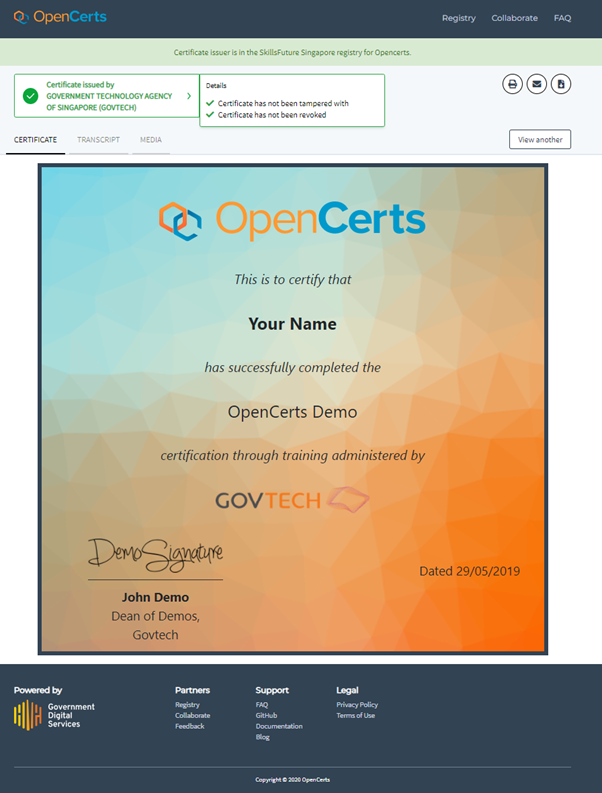Overview
OpenCerts uses blockchain to provide an easy and reliable way to issue and validate tamper-proof certificates. It provides a single place for all individuals, from students to employers, to verify certificates issued from any institution. OpenCerts was first conceptualised in collaboration with Ngee Ann Polytechnic (NP) in Nov 2017 and is now adopted by educational institutes within the OpenCerts consortium. Through OpenCerts, individuals can view their certificates, check that it has not been tampered with.
OpenCerts is powered by Government Digital Services (GDS), click here to find out more about OpenCerts.
What is OpenCerts?
The OpenCerts registry is maintained by SkillsFuture Singapore (SSG).
OpenCerts, part of Singapore’s Smart Nation initiative, enables issuance and validation of tamper-resistant academic certificates in a convenient and reliable manner. It was developed in cooperation with the OpenCerts Consortium.
OpenAttestation is a standard that helps to create Verifiable Documents. OpenCerts is a specific implementation, using OpenAttestation, to provide institutions a way to create Verifiable Certificates.
OpenCerts is the umbrella trademark under which GovTech has released a few key components:
- An open-source schema for publishing educational credentials.
- A set of tools for generating cryptographic protections for educational credentials.
- The OpenCerts online website for verifying the authenticity of OpenCerts files.

Why Should OpenCerts be Adopted?
OpenCerts was conceptualised to address three key objectives:
- To combat education fraud:
-
OpenCerts provides the means to verify if a document has been subjected to tampering and can be easily verified by the receiving party of such a document.
-
Additionally, verifiers of an OpenCerts certificate will be informed if a certificate had been revoked, without having to check back with the issuing organisation. Unlike PDFs which have been signed digitally, OpenCerts certificates can be revoked post-issuance. For example, if a student was found to have cheated after the certificate has already been issued. Previously, the holder of a certificate may still be in possession of his/her certificate, even though it had been revoked, and could still share with unsuspecting recipients.
- Increase speed of verification.
- A traditional request to verify a certificate requires contacting an educational institute. This could take days, if not weeks to be completed. Conversely, the OpenCerts platform provides an alternative to verify the authenticity of education certificates in a matter of seconds.
-
- OpenCerts allows for costs savings and the possibility to redeploy resources from educational institutes which had been previously used for the verification of certificates.
How do You Use OpenCerts?
Simply visit the OpenCerts portal through this link and drag and drop the certificate to be verified into the portal!
Volunteer Opportunities
To volunteer with the OpenCerts team, indicate the project name and complete the survey here
Skillsets
- React, Typescript, Ethereum
- Designer for visual and interactivity design
- Deployment on Netlify/AWS
Commmitment
- Work remotely as much as possible.
Contact Us
Reach out to the product team with your queries or feedback through this form.
Last updated 24 August 2022
Thanks for letting us know that this page is useful for you!
If you've got a moment, please tell us what we did right so that we can do more of it.
Did this page help you? - No
Thanks for letting us know that this page still needs work to be done.
If you've got a moment, please tell us how we can make this page better.

